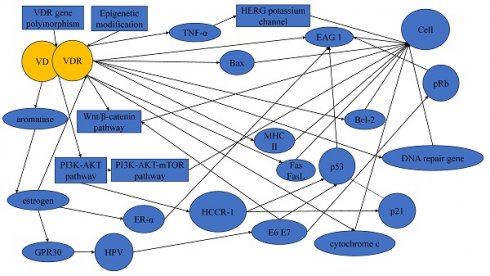3.2
Impact Factor
ISSN: 1837-9664
J Cancer 2024; 15(4):926-938. doi:10.7150/jca.87499 This issue Cite
Review
Vitamin D and Its Receptors in Cervical Cancer
1. Department of Epidemiology and Biostatistics, School of Public Health, Tianjin Medical University, Tianjin, China.
2. Tianjin Key Laboratory of Environment, Nutrition and Public Health, Tianjin, China.
3. Tianjin Center for International Collaborative Research in Environment, Nutrition and Public Health, Tianjin, China.
4. Department of Nutrition and Food Science, School of Public Health, Tianjin Medical University, Tianjin, China.
5. Department of Urology, The Second Hospital of Tianjin Medical University, Tianjin, China.
*These authors have contributed equally to this work and share correspondence and last authorship.
Abstract

Several studies have investigated the relationship between vitamin D (VD) and its receptors (VDR) and the risk of cervical cancer. However, the underlying mechanisms that underpin these associations remain incompletely comprehended. In this review, we analyzed the impacts of VD and VDR on cervical cancer and related mechanisms, and discussed the effects of VD, calcium, and other vitamins on cervical cancer. Our literature research found that VD, VDR and their related signaling pathways played indispensable roles in the occurrence and progression of cervical cancer. Epidemiological studies have established associations between VD, VDR, and cervical cancer susceptibility. Current studies have shown that the inhibitory effect of VD and VDR on cervical cancer may be attributed to a variety of molecules and pathways, such as the EAG potassium channel, HCCR-1, estrogen and its receptor, p53, pRb, TNF-α, the PI3K/Akt pathway, and the Wnt/β-catenin pathway. This review also briefly discussed the association between VDR gene polymorphisms and cervical cancer, albeit a comprehensive elucidation of this relationship remains an ongoing research endeavor. Additionally, the potential ramifications of VD, calcium, and other vitamins on cervical cancer has been elucidated, yet further exploration into the precise mechanistic underpinnings of these potential effects is warranted. Therefore, we suggest that further studies should focus on explorations into the intricate interplay among diverse molecular pathways and entities, elucidation of the mechanistic underpinnings of VDR polymorphic loci changes in the context of HPV infection and VD, inquiries into the mechanisms of VD in conjunction with calcium and other vitamins, as well as investigations of the efficacy of VD supplementation or VDR agonists as part of cervical cancer treatment strategies in the clinical trials.
Keywords: vitamin D, vitamin D receptor, cervical cancer

 Global reach, higher impact
Global reach, higher impact